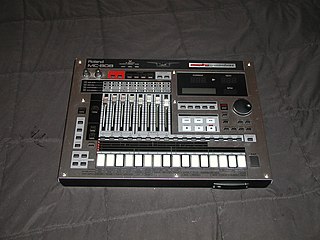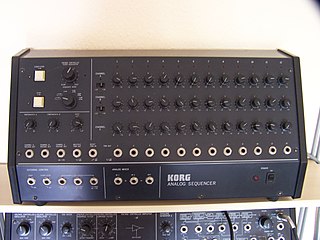A music sequencer is a device or application software that can record, edit, or play back music, by handling note and performance information in several forms, typically CV/Gate, MIDI, or Open Sound Control (OSC), and possibly audio and automation data for DAWs and plug-ins.

An electronic keyboard, portable keyboard, or digital keyboard is an electronic musical instrument, an electronic or digital derivative of keyboard instruments. Broadly speaking, the term electronic keyboard or just a keyboard can refer to any type of digital or electronic keyboard instrument. These include synthesizers, digital pianos, stage pianos, electronic organs and digital audio workstations. However, an electronic keyboard is more specifically a synthesizer with a built-in low-wattage power amplifier and small loudspeakers.

The Roland MC-303 is the first of a series of musical instruments known as a Groovebox. It combines a simple sound module with a sequencer to record and store notation, along with controls aimed at encouraging the musician to improvise the music while it is playing. Despite the number in its name and the attention it received at its launch, the MC-303 has more in common with other MC prefixed synthesizers, which contain built-in sequencers, than it does with the famous Roland TB-303. As the first Groovebox, the MC-303 was the first in a line of inexpensive products specifically targeted towards house DJs and amateur home musicians rather than professional producers. It was superseded by the Roland MC-505. It is the predecessor to the Roland JX-305, Roland D2, Roland MC-307, Roland EG-101, Roland MC-09, Roland MC-909, Roland MC-808, and most recently the Roland MC-707 in 2019, along with its more portable sibling, the Roland MC-101.

Novation Digital Music Systems Ltd. is a British musical equipment manufacturer, founded in 1992 by Ian Jannaway and Mark Thompson as Novation Electronic Music Systems. Today the company specializes in MIDI controllers with and without keyboards, both analog and virtual analog performance synthesizers, grid-based performance controllers, and audio interfaces. At present, Novation products are primarily manufactured in China.
The Yamaha AN1x is a DSP-based analog modeling synthesizer, produced by Yamaha Corporation from 1997 to 1998, and was marketed as an "analog physical modelling control synthesizer".

The Yamaha QY10 is a hand-held music workstation produced by the Yamaha Corporation in the early 1990s. Possessing a MIDI sequencer, a tone generator and a tiny single-octave keyboard, the portable and battery-powered QY10 enables a musician to compose music while traveling.

A sound module is an electronic musical instrument without a human-playable interface such as a piano-style musical keyboard. Sound modules have to be operated using an externally connected device, which is often a MIDI controller, of which the most common type is the musical keyboard. Another common way of controlling a sound module is through a sequencer, which is computer hardware or software designed to record and playback control information for sound-generating hardware. Connections between sound modules, controllers, and sequencers are generally made with MIDI, which is a standardized interface designed for this purpose.

The Roland MC-505 is a groovebox conceived in 1998 as a combination of a MIDI controller, a music sequencer , a drum machine, and a desktop synthesizer with many synthesis features: arpeggiator, oscillators, and voltage-controlled filter, control of attack, decay, sustain and release, diferents envelopes and 2 Lfo. It was released as the successor to the Roland MC-303 and is a compact version of the Roland JX-305 Groovesynth without the full set of 61 keys. It is also the predecessor to the Roland D2, Roland MC-307, Roland MC-909 and the Roland MC-808.

The Yamaha Motif is a series of music workstation synthesizers, first released by Yamaha Corporation in August 2001. The Motif replaced the EX series in Yamaha's line-up and was also based on the early Yamaha S series. Other workstations in the same class are the Korg Kronos and the Roland Fantom G. The series' successor is Yamaha Montage.

The Moog model 2090 Micromoog is a monophonic analog synthesizer produced by Moog Music from 1975 to 1979.

The discontinued Roland MC-909 Sampling Groovebox combines the features of a synthesizer, sequencer, and sampler, with extensive hands-on control of both the sound engine and the sequencing flow. It was intended primarily for live performance of pre-programmed patterns consisting of up to 16 tracks of MIDI data. It was released by Roland Corporation on October 8, 2002. This product was announced at the AES Fall Convention in 2002. It is the direct successor to the Roland MC-505 and is the predecessor to the Roland MC-808. Which eventually ended the "Groovebox by year 2010" line of products by Roland which began in the year 1996 with the Original Roland MC-303 groovebox. The Roland Groovebox began again resurgence in the year 2019 with a two new modern & redesign Roland MC-707 GROOVEBOX/Roland MC-101 GROOVEBOX. The Roland MC-909 was developed from the blueprint of Roland's own "Roland Fantom-S Workstation & Roland Fantom-X Workstation" and uses the same structure and operating system, with some differences regarding the Patterns section, not implemented in the Roland Fantom S/X6/X7/X8 Workstation.

The Korg MS2000 is a virtual analog synthesizer produced by the Japanese electronic musical instrument manufacturer Korg.

The Korg Wavestation is a vector synthesis synthesizer first produced in the early 1990s and later re-released as a software synthesizer in 2004. Its primary innovation was Wave Sequencing, a method of multi-timbral sound generation in which different PCM waveform data are played successively, resulting in continuously evolving sounds. The Wavestation's "Advanced Vector Synthesis" sound architecture resembled early vector synths such as the Sequential Circuits Prophet VS.

The Roland MC-808 was a groovebox, announced at the Winter NAMM in 2006. It is the successor to the late Roland MC-303, Roland MC-307, Roland MC-505 and Roland MC-909.

The Yamaha CS2x is a sample-based synthesizer released by the Yamaha Corporation in 1999. The CS2x is designed for maximum real-time control, according to Yamaha. It is the successor of the very successful Yamaha CS1x. Enhancements include 64-note polyphony, a bigger sample ROM and a 24 dB/oct LPF/HPF filter. The CS acronym stands for Control Synthesizer.

An analog sequencer is a music sequencer constructed from analog (analogue) electronics, invented in the first half of the 20th century.

The Sirius is a keyboard "groove-synth," featuring a subtractive hybrid-tone-generation synthesizer referred to as DTE synthesis introduced in 1997 by Quasimidi. The unit featured both real-time and step sequencers with pattern- and song-modes, capable of acting basic drum machine, groove-box, or sound-module.

The Yamaha DX21 is a digital controlled bi-timbral programmable analog synthesizer with a four operator synth voice generator which was released in 1985. It uses sine wave-based Frequency Modulation (FM) synthesis. It has two FM tone generators and a 32-voice random-access memory (RAM), 32 user voices and 128 read-only memory (ROM) factory preset sounds. As a programmable synth, it enables users to create their own unique synthesized tones and sound effects by using the algorithms and oscillators. The instrument weighs 8 kg (17.6 lbs). On its release, it sold for $795.
The Korg DRM-1 Digital Rhythm module built by Korg, in late 1987. It was introduced during 1987 Summer NAMM industry trade show in Chicago.
















